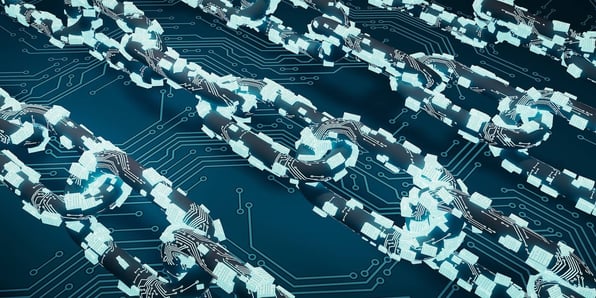Gavin Wood coined the phrase Web3 in 2014 to refer to the next iteration of the internet. In his view, decentralized data secured with blockchain technology would lessen big tech’s control over the data generated on the internet. Why should Facebook and Google make millions off consumer data? Shouldn’t people have more say in how their data is being used?
Although Wood’s vision of democratized data is open to debate, the technology that underlies Web3 is not. Organizations are already looking to decentralize their data as part of edge computing initiatives. Many are implementing artificial intelligence tools to help assemble and analyze data faster and more accurately. The following technologies are what will fuel the move to Web3.
Blockchain
Without blockchain, there would be no Web3. It is the technology that supports the exchange of data in a secure environment. Blockchain serves as a distributed ledger of verifiable transactions that are stored across multiple nodes. Once the data is recorded, it cannot be changed. Instead, a correction data block is added to the chain to correct the error.
Edge Computing
Edge computing refers to capturing, storing, and analyzing data as close to the collection point as possible. Data is no longer sent to a centralized data warehouse or lake. Data stores are located at intermediate points within the network, reducing the resources needed to manage and process the data.
Decentralization
With more data remaining at a network’s edge, companies do not need centralized databases, data warehouses, and data lakes. Instead, they can deploy storage nodes throughout the enterprise to minimize the amount of data that must flow back to a central location. The data can be encrypted so no one can gain access to the data even if multiple users are on the same platform. Decentralizing data makes it harder for cybercriminals to access a company’s data storage.
Artificial Intelligence
Artificial intelligence (AI) attempts to simulate human intelligence through algorithms mirroring human learning, reasoning, and self-correction
- Learning focuses on acquiring data and identifying rules that turn the data into actionable information.
- Reasoning is understanding the best algorithm for the task.
- Self-correction is designed to improve algorithms to ensure accurate results.
To be successful, AI requires access to volumes of data that facilitate learning and self-correction.
Web3 Technologies and Data Centralization
The impetus for decentralized vs centralized data did not come from a desire to be Web3-ready. It developed organically as companies realized it was more efficient to process the data at the point of acquisition. However, the alignment of Web3 technologies and business-driven data decentralization means greater synergies.
Edge Computing
Rather than sending volumes of data to a centralized location for processing, IT departments began deploying solutions that performed the centralized functions at the point of acquisition or network edge. In this context, the edge is an intermediary point between an endpoint and the core IT functionality that delivers the same capabilities as the centralized data environment.
The worldwide market for edge computing is expected to reach $176 billion by the end of 2022 as more companies deploy the technology to improve operations and reduce costs. It is projected to continue at a 14.8% annual growth through 2025, placing more pressure on existing internet structures to deliver high-performance and low latency solutions. Organizations will look to the edge for increased data security, improved performance, data compliance, and business intelligence.
Data Compliance
Securing data from hackers is only part of the data security requirements to protect consumer privacy. Regulations such as General Data Privacy Regulations (GDPR) and California’s Consumer Privacy Act (CCPA) are two recent measures that place more responsibility on organizations to protect user privacy and respond to end-user requests for the removal of personal data. Although many organizations push the requirement down the supply chain for compliance, they still face significant risks if violations are found.
Another advantage of decentralization is the ability to deploy solutions specific to a region or area. For example, data collected in California could be processed locally to ensure compliance with CCPA without impacting the entire data set. As more states look at implementing versions of CCPA, companies may find decentralization a more cost-effective solution than applying individual regulations to a centralized data center.
Data Security
In environments where data is secured in a single location, the potential for a catastrophic breach is higher than if the data were stored in multiple locations. Think of data breaches such as Equifax or Capital One. According to IBM, data breaches of this magnitude can result in an average loss of $4.6 million at a rate of $160.00 per record.
With decentralized data stores, the odds of a catastrophic compromise are reduced. While cybercriminals may breach a single data store, it’s unlikely that they would compromise multiple stores if a company maintains robust security defenses. Add blockchain technology to a decentralized data structure and the chances of a successful breach and sale of data are significantly reduced.
Performance
Artificial intelligence needs centralized data stores with clean information. Instead of dumping every byte of data into a large data lake or warehouse, organizations need to select only the pertinent information to deliver to a central store. Making sure that only the applicable data is used can improve AI performance while decentralizing non-essential data points.
At the same time, companies need to keep data at the edge to reduce the strain on their networks. Keeping data close to a network’s endpoints means results can be delivered quickly. In environments where agility is key, decentralizing data enables organizations to adjust incrementally as the edge requires. Whether it is remote work or hybrid computing, decentralization is becoming the standard for data dissemination.
Business Intelligence
More than ever data-driven business intelligence is needed. Companies must assess when and where to adopt Web3 technologies and ensure existing systems are maintained. ChristianSteven Software offers a Power BI Reports Scheduler (PBRS) that schedules and delivers reports and dashboards across an enterprise. It doesn’t matter if the data is in a centralized store or at the network’s edge, PBRS can deliver Power BI data reports on time, every time. Why not download a 30-day free trial from ChristianSteven website to see how PBRS works?


